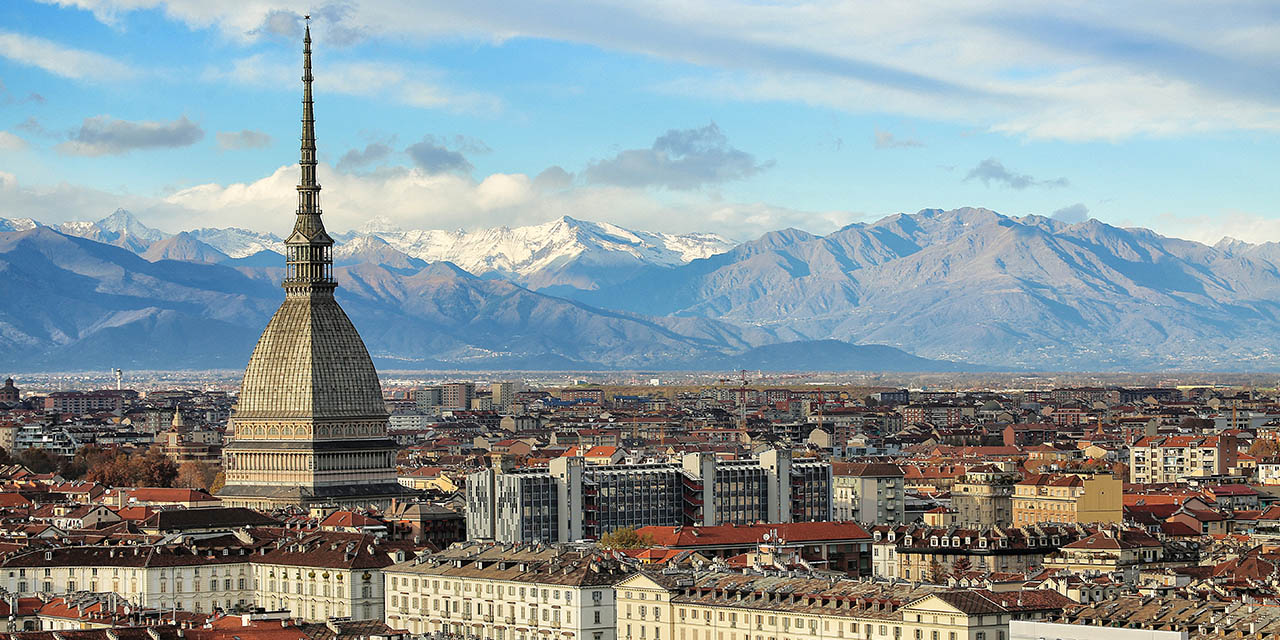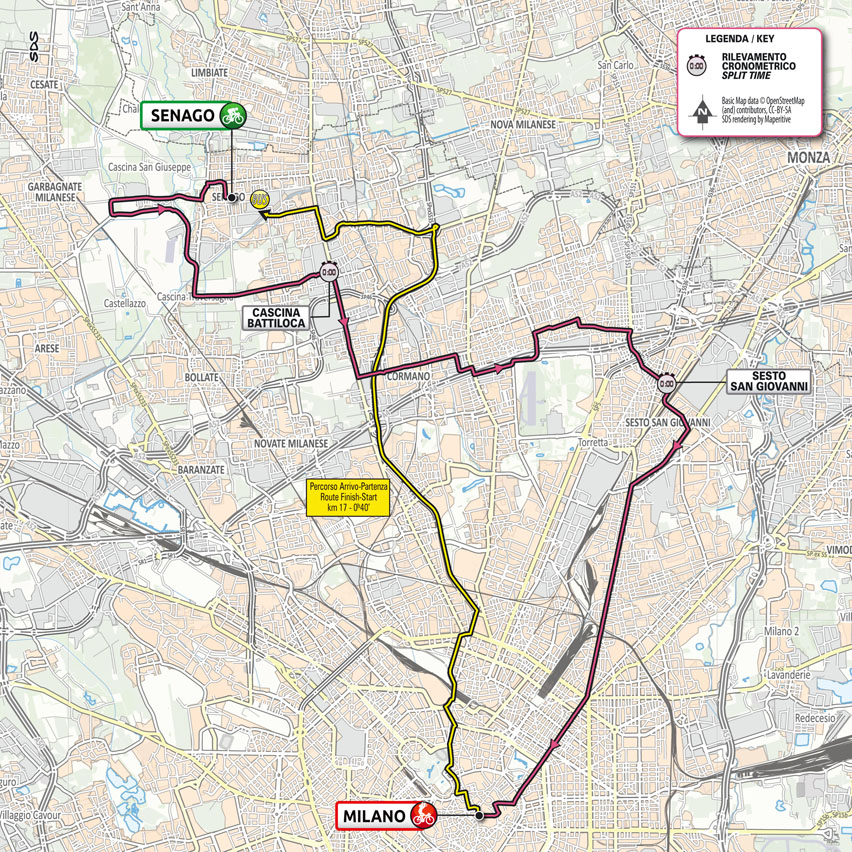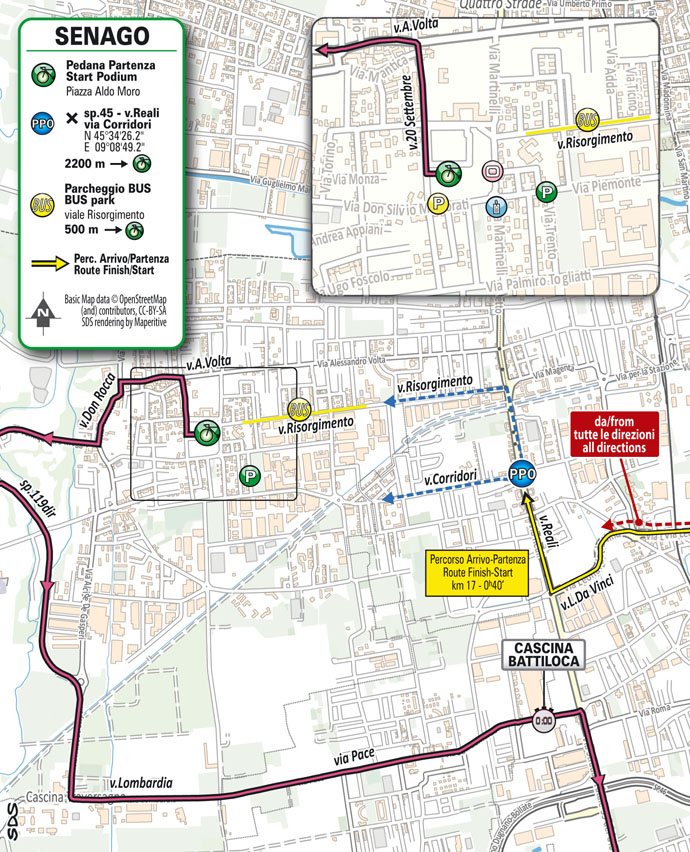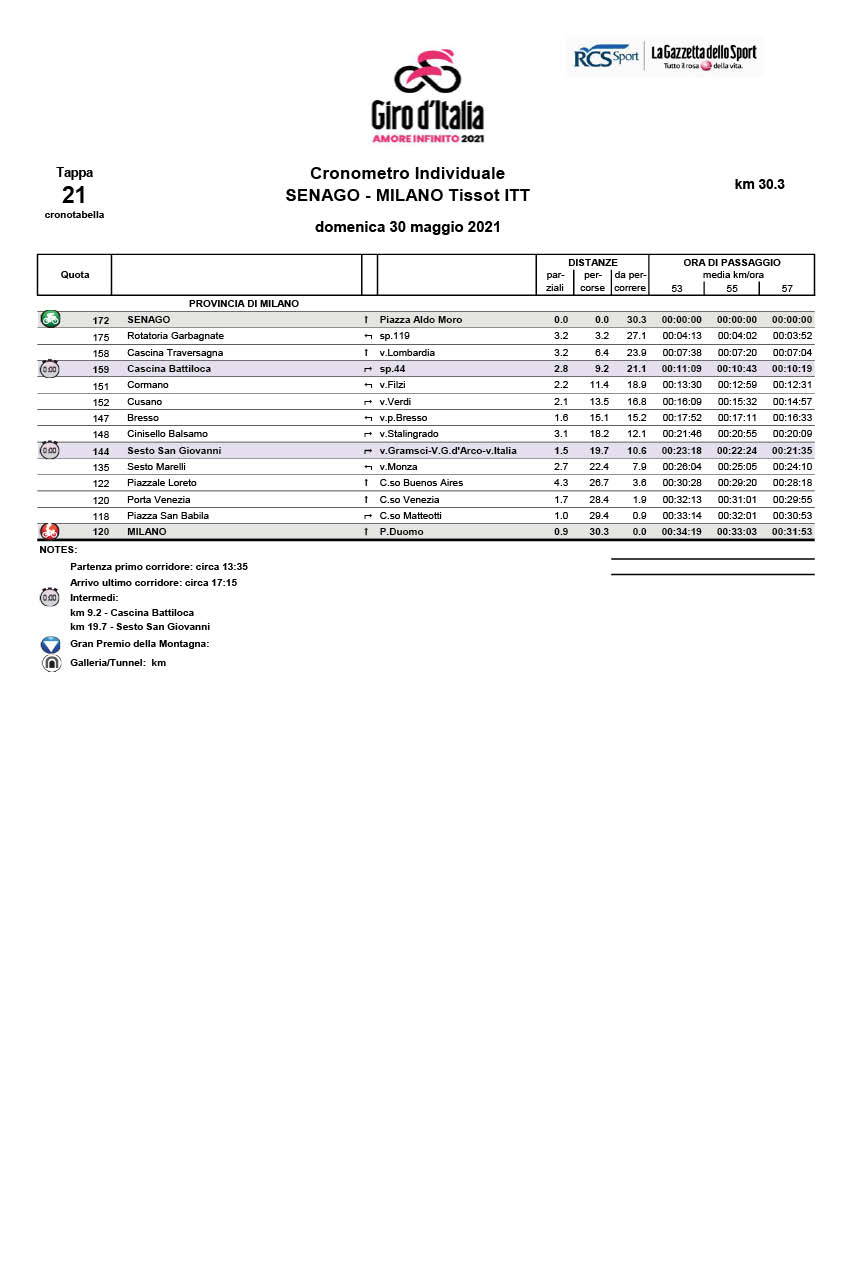profile
map
technical info
The start of the ITT is set in the centre of Senago. The stage is played out on wide and mostly straight roads, as far as Sesto San Giovanni. From here on, the course runs almost straight up to 2 km from the finish in Piazza Duomo. Tramway tracks, roundabouts and street furniture are found repeatedly along the route.
Final kilometres
In the stage finale, the route first runs on wide avenues, and then on narrowed roads over the last few hundred metres, with several consecutive 90-degree turns over the last 100-150 metres, before entering Piazza Duomo. The home straight (250 m) is on 6 m wide stone-paved road.
start / finish
itinerary timetable
tourist info
Host city:
Senago
Milano
Overview
World capital of fashion and design, Milan lives poised between a centuries-long historical and cultural tradition and a creative stance looking forward to innovation and the world at large. Its destiny is already in its name, Mediolanum, meaning “place in the middle” between different territories and peoples, a hub for trade and commerce from the very beginning. Born as a Celtic village it has been through the centuries the Capital of the Western half of the Roman Empire, a major Renaissance Court at the time of Ludovico il Moro and Leonardo da Vinci, a place of plunder for French, Spaniards, Austrians – finally to be annexed to the Kingdom of Italy in 1861. From the 18th century to the present Milan has never ceased to renew its look, from the Neo-Classical lines of Teatro alla Scala to the sumptuous Galleria Vittorio Emanuele and finally to the high-rise of its skyscrapers that, from Gio Ponti to the international archistars, have re-drawn its skyline.
Food
Tradition and innovation also co-exist in the Milan of taste, between ancient recipes and contemporary gourmet versions. History is represented by risotto alla milanese, with marrowbone steak and saffron rice, mondeghili (fried meatballs), rostin negàa (roast doused in white wine). The typical Christmas cake is Panettone, now famous throughout the world.
Milan provides cooking for every taste and every budget: 20 Michelin-starred restaurants, countless trattorie, local eateries, vegetarian, romantic, traditional and ethnic. But also bars and pubs to celebrate the rite of aperitivo in the evening, with elaborate cocktails and tasty finger food.
Points of interest
A textbook visit to the city can only start from its centre: the Duomo, with its marbles, its spires, its great windows and its five centuries of history; the elegant Galleria Vittorio Emanuele; Piazza della Scala, with the Theatre and the monument to Leonardo da Vinci. Milan’s history is especially visible in centuries of churches and Christian symbols: the imposing antiquity of San Lorenzo, with its columns; the beauty of Lombard Romanic in Sant’Ambrogio; the Renaissance in Santa Maria delle Grazie, with Leonardo’s Last Supper, the cloister and the sacristy; the frescoed interior of San Maurizio al Monastero Maggiore. A place of history and Art, but of protected leisure by its courts and towers as well, Castello Sforzesco houses masterpieces such as Michelangelo’s Pietà Rondanini and the Sala delle Asse with the recently restored wall paintings by Leonardo.
Milano offers enthusiasts more than 80 museums, such as Pinacoteca di Brera, Pinacoteca Ambrosiana, Gallerie d’Italia, Galleria d’Arte Moderna or its House Museums Focus is not on art only but on science as well: look up Museo Nazionale di Scienza e Tecnologia, named after Leonardo. The contemporary has found home at Museo del Novecento, Fondazione Prada, the new Museo del Design at the Triennale, while Palazzo Reale, PAC – Padiglione di Arte Contemporanea and MUDEC periodically host exhibitions of international standing.
With a short metro or tramcar trip one can reach the charming alleyways of the Brera district, take an evening stroll by the romantic Navigli, window-shop across fashion streets like via Montenapoleone or via della Spiga, breathe freely in Parco Sempione or in another of the many parks and gardens. While the new Milan soars in the Porta Nuova district, with Piazza Gae Aulenti and the Bosco Verticale; and in the CityLife area, with its three towers.
Milan also captivates for the rich vibrancy of the events held throughout the year, starting from the Week&City series, successful in involving the whole city under the banner of a shared theme. Among the most famous are the Fashion Weeks, bringing to Milan the big pret-à-porter brands together with the new emerging fashion houses; Design Week, during Salone del Mobile (Furniture Fair), when creativity takes over the city with events and exhibits; and Art Week, dedicated to contemporary art, with openings, temporary exhibitions and international guests.







































































































